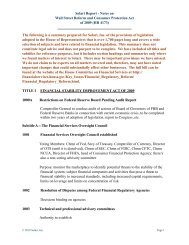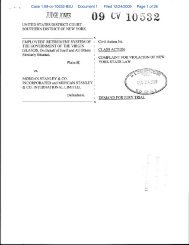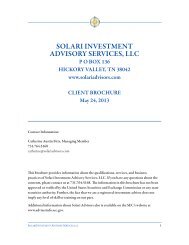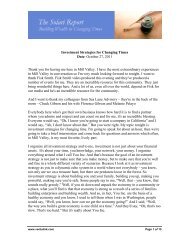Q3 01webb.qxd - Dillon Read & the Aristocracy of Stock Profits
Q3 01webb.qxd - Dillon Read & the Aristocracy of Stock Profits
Q3 01webb.qxd - Dillon Read & the Aristocracy of Stock Profits
Create successful ePaper yourself
Turn your PDF publications into a flip-book with our unique Google optimized e-Paper software.
S ANDERS R ESEARCH A SSOCIATES<br />
AMERICAN MANAGEMENT SYSTEM INC. STOCK PRICE The result <strong>of</strong> this situation is summed up<br />
by this statistic: twenty or thirty years<br />
ago, 70 cents <strong>of</strong> every dollar <strong>of</strong> federal<br />
spending went into <strong>the</strong> pocket <strong>of</strong> someone<br />
in <strong>the</strong> neighbourhood it was targeted at.<br />
Today that number is less than 30 cents.<br />
What that means is that investment in<br />
community development has enjoyed<br />
about a 300 - 400% increase in overhead,<br />
at <strong>the</strong> same time that technology has<br />
actually made it possible for overhead to<br />
drop dramatically The public policy<br />
“solution” has been to outsource govern-<br />
Source: Edgaronline<br />
ment functions to make <strong>the</strong>m more productive.<br />
In fact, this jump in overhead is<br />
simply a subsidy provided to private companies and organisations that receive<br />
<strong>the</strong>reby a guaranteed return regardless <strong>of</strong> performance. We have subsidies and<br />
financing to support housing programs that make no economic sense except for<br />
<strong>the</strong> property managers and owners who build and manage it for layers <strong>of</strong> fees.<br />
We have a horde <strong>of</strong> service providers to federal programs who are “expert” at<br />
helping communities <strong>of</strong> people who rarely show signs <strong>of</strong> improvement.<br />
TWENTY OR<br />
THIRTY YEARS AGO,<br />
70 CENTS<br />
ON THE DOLLAR<br />
WENT INTO THE<br />
POCKET OF<br />
SOMEONE IN THE<br />
NEIGHBOURHOOD.<br />
TODAY,<br />
THAT NUMBER IS<br />
LESS THAN<br />
30 CENTS.<br />
At HUD, it is primarily defence contractors such as Lockheed, American<br />
Management Systems (AMS) and DynCorp who run <strong>the</strong>se same programs. Such<br />
companies tend to have numerous private conflicts <strong>of</strong> interest through companies<br />
owned directly or indirectly by <strong>the</strong>ir investors. They make money from <strong>the</strong><br />
programs and serve as a revolving door for personnel between <strong>the</strong>m and <strong>the</strong><br />
government. Not surprisingly, <strong>the</strong>y find it impossible to run HUD efficiently no<br />
matter how much <strong>the</strong>y are paid. Incompetence is a moneymaker.<br />
Take AMS <strong>of</strong> Fairfax, Virginia, for example. It is reported to have earned<br />
$206MM since 1993 to build and run <strong>the</strong> HUD accounting system, HUD CAPS.<br />
That system has had mysterious periods <strong>of</strong> not working during which everyone<br />
was too busy to use a pencil and paper to reconcile <strong>the</strong> checkbook with<br />
Treasury. In fiscal 1999, HUD refused to publish audited financial statements.<br />
Total reported undocumentable adjustments to force balanced books in fiscal<br />
1998-1999 are now $149 billion.<br />
When you see a company hired to operate financial control and accounting systems<br />
paid $206 million to mismanage or misreport $149 billion, you begin to<br />
appreciate <strong>the</strong> economics <strong>of</strong> bubblemania.<br />
One way to prevent such discrepancies would be to check that <strong>the</strong> revenues<br />
flowing out <strong>the</strong> door at HUD matched up with <strong>the</strong> revenues reported to <strong>the</strong> IRS<br />
at Treasury. This is a reasonable idea. However, today <strong>the</strong> head <strong>of</strong> <strong>the</strong> IRS is <strong>the</strong><br />
former Chairman <strong>of</strong> AMS (who was provided with a waiver that allows him to<br />
keep his significant position in AMS stock).<br />
The truth is that <strong>the</strong> private sector is eating government programs and<br />
administration alive. This means that fundamental economic productivity is<br />
decreasing while government investment earns a constantly decreasing rate <strong>of</strong><br />
return to taxpayers. This has been going on for a long time. For example, in<br />
1988, I was invited to a budget briefing for business leaders by Secretary <strong>of</strong><br />
2001 THIRD Q UARTER C OMMENTARY - PAGE 15












